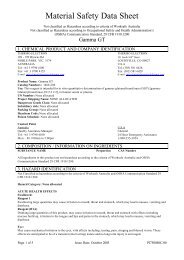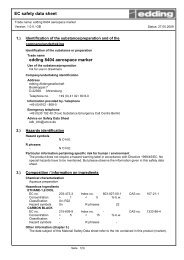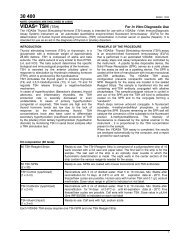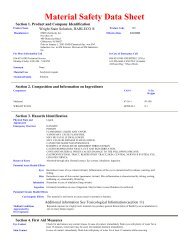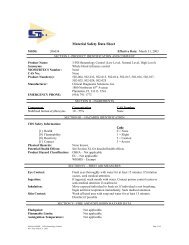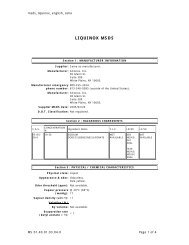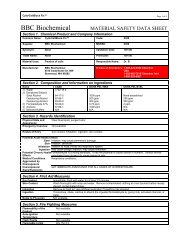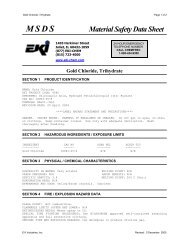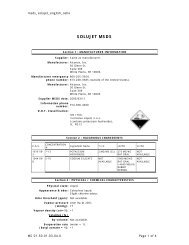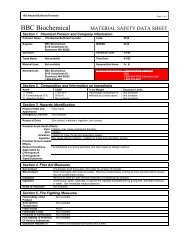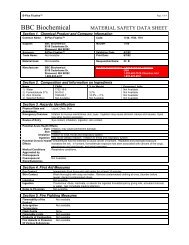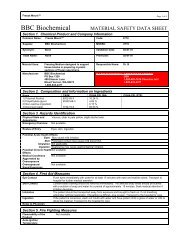Alcohol Prep Pads - Unimed Corp
Alcohol Prep Pads - Unimed Corp
Alcohol Prep Pads - Unimed Corp
- No tags were found...
You also want an ePaper? Increase the reach of your titles
YUMPU automatically turns print PDFs into web optimized ePapers that Google loves.
MATERIAL SAFETY DATA SHEETWEBCOL/CURITY <strong>Alcohol</strong> <strong>Prep</strong> <strong>Pads</strong>1. PRODUCT AND COMPANY IDENTIFICATIONProduct NameWEBCOL/CURITY <strong>Alcohol</strong> <strong>Prep</strong> <strong>Pads</strong>Use/SizeWound CleanerProduct Numbers 5033, 5110, 5150, 5750, 6818Manufacturer/SupplierTyco Healthcare/ KendallAddress15 Hampshire StreetMansfield, MA 02048Phone Number(508) 261-8000 (Monday – Friday 8:00 am to 5:00 pm)Chemtrec Number (800) 424-9300Revision Date: January 30, 2004MSDS Date: September 14, 1999This MSDS has been compiled in accordance with - EC Directive 91/155/EC - OSHA's Hazcom Standard (29 CFR 1910.1200)2. COMPOSITION/INFORMATION ON THE COMPONENTSComponent Name CAS#/Codes Concentration R Phrases ClassificationIsopropyl alcohol 67-63-0200-746-9>60% R11, R36, R67 F, Xi3. HAZARD IDENTIFICATIONEU Main HazardsHighly flammable.Irritating to eyes.Vapors may cause drowsiness and dizzinessRoutes of Entry- Absorption - Eye contact - Ingestion - Inhalation - Skin contactCarcinogenic StatusNot considered carcinogenic by NTP, IARC, and OSHA.Target Organs- Central Nervous System - Skin - Eye - Liver – Respiratory SystemHealth Effects - EyesLiquid, mist or vapor will cause conjunctival irritation and possibly corneal damage.Health Effects - SkinRepeated or prolonged contact may produce defatting of the skin leading to irritation and dermatitis.Liquid may be absorbed through the skin but not in toxicologically significant amounts, unless the areaof contact is large and exposure prolonged.Health Effects - IngestionSwallowing may have the following effects:- irritation of mouth, throat and digestive tract - central nervous system depressionA large dose may have the following effects:- dizziness - drowsiness - headache - mental confusion - nerve damage leading to numbness andmuscle weakness - fall of blood pressure - liver damage - lung damageHealth Effects - InhalationExposure to vapor may have the following effects:Revision Date: January 30, 2004 Page 1 of 7
MATERIAL SAFETY DATA SHEETWEBCOL/CURITY <strong>Alcohol</strong> <strong>Prep</strong> <strong>Pads</strong>3. HAZARD IDENTIFICATION- irritation of nose, throat and respiratory tract - central nervous system depressionExposure to vapor at high concentrations may have the following effects:- dizziness - drowsiness - headache - mental confusion - lung damage - fall of blood pressure -liver damage - nerve damage leading to numbness and muscle weakness4. FIRST AID MEASURESEyes:Immediately flood the eye with plenty of water for at least 15 minutes, holding the eye open. Obtainmedical attention if soreness or redness persists.SkinImmediately flood the skin with large quantities of water, preferably under a shower. Removecontaminated clothing and continue washing . Contaminated clothing should be washed or drycleanedbefore re-use. Obtain medical attention if blistering occurs or redness persists.IngestionDo not induce vomiting. Have victim drink 1-3 glasses of water to dilute stomach contents. If there isdifficulty in breathing, give oxygen. Obtain medical attention immediately.InhalationRemove from exposure. If there is difficulty in breathing, give oxygen. Obtain medical attentionimmediately.Advice to PhysiciansMonitor for systemic secondary effects on liver and kidney; support and treat.5. FIRE FIGHTING MEASURESExtinguishing MediaUse foam, dry chemical or carbon dioxide. Be aware of the possibility of re-ignition. Keep containersand surroundings cool with water spray.Unusual Fire and Explosion HazardsVapors can travel a considerable distance to a source of ignition and flashback. Flashback can occurif air temperature exceeds flash point. Be aware of possibility of re-ignition.Protective Equipment for Fire-FightingWear full protective clothing and self-contained breathing apparatus.6. ACCIDENTAL RELEASE MEASURESContain and absorb using earth, sand or other inert material. Transfer into suitable containers forrecovery or disposal. Wear appropriate protective clothing. Eliminate all sources of ignition. Vaporscan accumulate in low areas. Consider need for evacuation. Prevent the material from enteringdrains or water courses. Notify authorities if spill has entered water course or sewer or hascontaminated soil or vegetation.7. HANDLING AND STORAGEUse in well ventilated area. Use local exhaust ventilation. Avoid inhaling vapor. Avoid contact withRevision Date: January 30, 2004 Page 2 of 7
MATERIAL SAFETY DATA SHEETWEBCOL/CURITY <strong>Alcohol</strong> <strong>Prep</strong> <strong>Pads</strong>10. STABILITY AND REACTIVITYStabilityStable under normal conditions.Conditions to Avoid- Heat - High temperatures - Static discharge - Exposure to direct sunlight - Mechanical shockMaterials to Avoid- Strong oxidizing agents - Acids - Halogens - Aluminum - Acid anhydrides - Isopropyl alcohol mayattack some forms of plastic, rubber and coatingsHazardous PolymerizationWill not occur.Hazardous Decomposition Products- oxides of carbon11. TOXICOLOGICAL INFORMATIONAcute ToxicityLow order of acute toxicity predicted. Material may be harmful by skin absorption.Isopropyl <strong>Alcohol</strong>: Oral LD50 (rat) 5045 mg/kg. Dermal LD50 (rabbit) 12800mg/kg. Inhalation LCLO(rat) 1600ppm 4hChronic Toxicity/CarcinogenicityThis product is not expected to cause long term adverse health effects.(Isopropyl <strong>Alcohol</strong>) IARC assessment: this product is not classifiable as to its carcinogenicity tohumans (Group 3). Chronic/Subchronic studies resulted in adverse effects to: - liver - spleen -biochemical effects - brain tissue degeneration - changes in reflex behavior - sensory nerve damageGenotoxicityThis product is not expected to cause any mutagenic effects.Reproductive/Developmental ToxicityThis product is not expected to cause reproductive or developmental health effects.(Isopropyl <strong>Alcohol</strong>) Experimental studies in animals have provided some evidence of embryo/fetoxicityand birth defects only at doses producing marked maternal toxicity.12. ECOLOGICAL INFORMATIONMobility(Isopropyl <strong>Alcohol</strong>)If released to soil, isopropyl alcohol is expected to have very high mobility.Persistence/Degradability(Isopropyl <strong>Alcohol</strong>)Isopropyl alcohol is readily degraded in aerobic aqueous systems.Bio-accumulation(Isopropyl <strong>Alcohol</strong>)An estimated BCF of 3 suggests the potential for bioconcentration in aquatic organisms is low.Ecotoxicity(Isopropyl <strong>Alcohol</strong>)Tests on the following species gave a 96h LC50 of 1150mg/litre: - brown shrimpTests on the following species gave a 96h LC50 of 6.12-9.64mg/litre: - fathead minnowsRevision Date: January 30, 2004 Page 4 of 7
MATERIAL SAFETY DATA SHEETWEBCOL/CURITY <strong>Alcohol</strong> <strong>Prep</strong> <strong>Pads</strong>13. DISPOSALDispose of in accordance with all applicable local and national regulations. Labels should not beremoved from containers until they have been cleaned. Do not cut, puncture or weld on or near to thecontainer. Do not incinerate closed containers. Empty containers may contain hazardous residues.Dispose of containers with care.14. TRANSPORT INFORMATIONDOT CFR 172.101 DataProper Shipping NameClassUN NumberPacking GroupClassification for AIRTransport(IATA):Not Regulated per 49 CFR 173.4 Small Quantity ExemptionNoneNoneNoneNoneConsult current IATA Regulations prior to shipping by air.15. REGULATORY INFORMATIONEU Label InformationClassification and labelling have been performed according to EU directives 67/548/EEC and 99/45/ECincluding amendments.EU Hazard Symbol and Indication of DangerF - Highly flammableXi - IrritantR phrasesR11 - Highly flammable.R36 - Irritating to eyes.R67 - Vapours may cause drowsiness and dizziness.S phrasesS2 - Keep out of reach of children.S7 - Keep container tightly closed.S16 - Keep away from sources of ignition - No smoking.S24/25 - Avoid contact with skin and eyes.S26 - In case of contact with eyes, rinse immediately with plenty of water and seek medical advice.US REGULATIONS(Federal, State) and INTERNATIONAL CHEMICAL REGISTRATION LAWSTSCA ListingThis product contains ingredients that are listed on or exempt from listing on the EPA Toxic SubstanceControl Act Chemical Inventory.EINECS ListingAll ingredients in this product are listed on the European Inventory of Existing Commercial ChemicalSubstances (EINECS) or are exempt from listing.DSL (Canadian) ListingAll ingredients in this product are listed on the Domestic Substance List (DSL).MA Right To Know LawAll components have been checked for inclusion on the Massachusetts Substance List (MSL). ThoseRevision Date: January 30, 2004 Page 5 of 7
MATERIAL SAFETY DATA SHEETWEBCOL/CURITY <strong>Alcohol</strong> <strong>Prep</strong> <strong>Pads</strong>15. REGULATORY INFORMATIONcomponents present at or above the de minimus concentration include: - Isopropyl <strong>Alcohol</strong>PA Right To Know LawThis product contains the following chemicals found on the Pennsylvania Hazardous Substance List:- Isopropyl <strong>Alcohol</strong>NJ Right To Know LawThis product contains the following chemicals found on the NJ Right To Know Hazardous SubstanceList: - Isopropyl <strong>Alcohol</strong>California Proposition 65This product does not contain materials which the State of California has found to cause cancer, birthdefects or other reproductive harm.SARA Title III Sect. 302 (EHS)This product does not contain any chemicals subject to SARA Title III Section 302.SARA Title III Sect. 304This product does not contain any chemicals subject to SARA Title III Section 304.SARA Title III Sect. 311/312 CategorizationImmediate (Acute) Health HazardDelayed (Chronic) Health HazardFlammableSARA Title III Sect. 313This product does not contain a chemical which is listed in Section 313 at or above de minimisconcentrations.16. OTHER INFORMATIONNFPA RatingsNFPA Code for Flammability - 3NFPA Code for Health - 1NFPA Code for Reactivity - 0NFPA Code for Special Hazards - NoneHMIS RatingsHMIS Code for Flammability - 3HMIS Code for Health - 1HMIS Code for Reactivity - 0HMIS Code for Personal Protection - See Section 8AbbreviationsN/A: Denotes no applicable information found or availableCAS#: Chemical Abstracts Service NumberACGIH: American Conference of Governmental Industrial HygienistsOSHA: Occupational Safety and Health AdministrationTLV: Threshold Limit ValuePEL: Permissible Exposure LimitSTEL: Short Term Exposure LimitNTP: National Toxicology ProgramIARC: International Agency for Research on CancerEU: European UnionR: RiskS: Safety<strong>Prep</strong>ared By:EnviroNet LLC.Revision Date: January 30, 2004 Page 6 of 7
MATERIAL SAFETY DATA SHEETWEBCOL/CURITY <strong>Alcohol</strong> <strong>Prep</strong> <strong>Pads</strong>15. REGULATORY INFORMATIONThe information and recommendations presented in this MSDS are based on sources believed to beaccurate; therefore, The Kendall Company assumes no liability for the accuracy or completeness ofthis information. It is the user's responsibility to determine the suitability of the information for theirparticular purposes.Revision Date: January 30, 2004 Page 7 of 7



